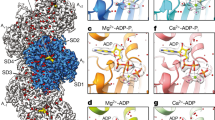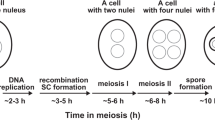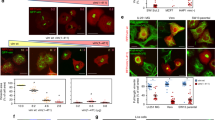Abstract
The altered morphology, disappearance or ‘disruption’ of actin filaments (microfilaments) in cells treated with cytochalasin1 has sometimes been attributed to depolymerization of filamentous actin (F-actin) to its globular subunit (G-actin), but attempts to confirm that mechanism have been inconclusive. Treatment of purified actin filaments with cytochalasin B (CB) decreased their viscosity2,3, consistent with depolymerization, which was not, however, revealed by electron microscopy4, although the filaments appeared abnormal5. CB also increased the ATP-ase activity of F-actin, suggesting that it had been destabilized3, while actin filaments in the acrosomal process were not depolymerized6. CB or cytochalasin D (CD) can dissolve actin gels (reviewed in ref. 7, see also refs 8 and 9) without depolymerizing their filaments. The ‘disrupted’ actin structures in CD-treated cells bound heavy meromysin10, indicating that at least some of the cellular actin was filamentous. Using a rapid assay for G- and F-actin in cell extracts, based on the inhibition of DNase I11, we have found that neither short-nor long-term exposure of HEp-2 cells to CD produce net depolymerization of actin filaments.
This is a preview of subscription content, access via your institution
Access options
Subscribe to this journal
Receive 51 print issues and online access
$199.00 per year
only $3.90 per issue
Buy this article
- Purchase on Springer Link
- Instant access to full article PDF
Prices may be subject to local taxes which are calculated during checkout
Similar content being viewed by others
References
Tanenbaum, S. W. (ed.) Cytochalasins Biochemical and Cell Biological Aspects (Elsevier/North-Holland, Amsterdam, 1978).
Spudich, J. A. & Lin, S. Proc. natn. Acad. Sci. U.S.A. 69, 442–446 (1972).
Löw, I. & Dancker, P. Biochim. biophys. Acta 430, 366–374 (1976).
Forer, A., Emerson, J. & Behnke, D. Science 175, 774–776 (1972).
Spudich, J. A. Cold Spring Harb. Symp. quant. Biol. 37, 585–594 (1972).
Sanger, J. W. & Sanger, J. M. J. exp. Zool. 193, 441–447 (1975).
Weihing, R. R. in Cytochalasins Biochemical and Cell Biological Aspects (ed. Tanenbaum, S. W.) 431–444 (Elsevier/North-Holland, Amsterdam, 1978).
Mimura, N. & Asano, A. Nature 272, 273–276 (1978).
Ishiura, M. & Okada, Y. J. Cell Biol. 80, 465–480 (1979).
Miranda, A. F., Godman, G. C. & Tanenbaum, S. W. J. Cell Biol. 62, 406–423 (1974).
Blikstad, I., Markey, F., Carlsson, L., Persson, T. & Lindberg, U. Cell 15, 935–943 (1978).
Bradford, M. M. Analyt. Biochem. 72, 248–254 (1976).
Miranda, A. F., Godman, G. C., Deitch, A. D. & Tanenbaum, S. W. J. Cell Biol. 61, 481–500 (1974).
Godman, G. C., Miranda, A. F., Deitch, A. D. & Tanenbaum, S. W. J. Cell Biol. 64, 644–667 (1975).
Gordon, D. J., Boyer, J. L. & Korn, E. D. J. biol. Chem. 252, 8300–8309 (1977).
Carlsson, L., Nyström, L.-E., Sundkvist, I., Markey, F. & Lindberg, U. J. molec. Biol. 115, 465–483 (1977).
Hartwig, J. H. & Stossel, T. P. J. molec. Biol. 134, 539–553 (1979).
Lin, D. C. & Lin, S. Proc. natn. Acad. Sci. U.S.A. 76, 2345–2349 (1979).
Brenner, S. R. & Korn, E. D. J. biol. Chem. 254, 9982–9985 (1979).
Brown, S. S. & Spudich, J. A. J. Cell Biol. 83, 657–662 (1979).
Korn, E. D. Proc. natn. Acad. Sci. U.S.A. 75, 588–599 (1978).
Dancker, P. & Löw, I. Z. Naturforsch. 34 c, 555–557 (1979).
Brenner, S. L. & Korn, E. D. J. biol. Chem. 255, 841–844 (1980).
Tannenbaum, J. in Cytochalasins Biochemical and Biological Aspects (ed. Tanenbaum, S. W.) 521–559 (Elsevier/North-Holland, Amsterdam, 1978).
Godman, G. C. & Miranda, A. F. in Cytochalasins Biochemical and Biological Aspects (ed. Tanenbaum, S. W.) 277–429 (Elsevier/North-Holland, Amsterdam, 1978).
Author information
Authors and Affiliations
Rights and permissions
About this article
Cite this article
Morris, A., Tannenbaum, J. Cytochalasin D does not produce net depolymerization of actin filaments in HEp-2 cells. Nature 287, 637–639 (1980). https://doi.org/10.1038/287637a0
Received:
Accepted:
Issue Date:
DOI: https://doi.org/10.1038/287637a0
This article is cited by
Comments
By submitting a comment you agree to abide by our Terms and Community Guidelines. If you find something abusive or that does not comply with our terms or guidelines please flag it as inappropriate.



